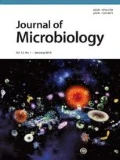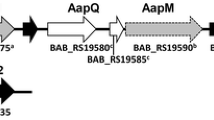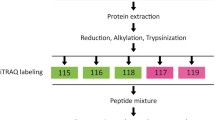Abstract
Brucella abortus is the etiological agent of bovine brucellosis, an infectious disease of humans and cattle. Its pathogenesis is mainly based on its ability to survive and multiply inside macrophages. It has been demonstrated that if B. abortus ferrochelatase cannot incorporate iron into protoporphyrin IX to synthesize heme, the intracellular replication and virulence in mice is highly attenuated. Therefore, it can be hypothesized that the unavailability of iron could lead to the same attenuation in B. abortus pathogenicity. Thus, the purpose of this work was to obtain a B. abortus derivative unable to keep an internal iron pool and test its ability to replicate under iron limitation. To achieve this, we searched for iron-storage proteins in the genome of brucellae and found bacterioferritin (Bfr) as the sole ferritin encoded. Then, a B. abortus bfr mutant was built up and its capacity to store iron and replicate under iron limitation was investigated. Results indicated that B. abortus Bfr accounts for 70% of the intracellular iron content. Under iron limitation, the bfr mutant suffered from enhanced iron restriction with respect to wild type according to its growth retardation pattern, enhanced sensitivity to oxidative stress, accelerated production of siderophores, and altered expression of membrane proteins. Nonetheless, the bfr mutant was able to adapt and replicate even inside eukaryotic cells, indicating that B. abortus responds to internal iron starvation before sensing external iron availability. This suggests an active role of Bfr in controlling iron homeostasis through the availability of Bfr-bound iron.
Similar content being viewed by others
References
Abdul-Tehrani, H., A.J. Hudson, Y.S. Chang, A.R. Timms, C. Hawkins, J.M. Williams, P.M. Harrison, J.R. Guest, and S.C. Andrews. 1999. Ferritin mutants of Escherichia coli are iron deficient and growth impaired, and fur mutants are iron deficient. J. Bacteriol. 181, 1415–1428.
Almirón, M., A.J. Link, D. Furlong, and R. Kolter. 1992. A novel DNA-binding protein with regulatory and protective roles in starved Escherichia coli. Genes Dev. 6, 2646–2654.
Almirón, M., M. Martinez, N. Sanjuan, and R.A. Ugalde. 2001. Ferrochelatase is present in Brucella abortus and is critical for its intracellular survival and virulence. Infect. Immun. 69, 6225–6230.
Andrews, S.C. 1998. Iron storage in bacteria. Adv. Microb. Physiol. 40, 281–351.
Arnow, L.E. 1937. Colorimetric determination of the components of 3,4-dihydroxyphenylalanine-tyrosine mixtures. J. Biol. Chem. 118, 531–537.
Bellaire, B.H., P.H. Elzer, C.L. Baldwin, and R.M. Roop 2nd. 1999. The siderophore 2,3-dihydroxybenzoic acid is not required for virulence of Brucella abortus in BALB/c mice. Infect. Immun. 67, 2615–2618.
Boughammoura, A., B.F. Matzanke, L. Böttger, S. Reverchon, E. Lesuisse, D. Expert, and T. Franza. 2008. Differential role of ferritins in iron metabolism and virulence of the plant-pathogenic bacterium Erwinia chrysanthemi 3937. J. Bacteriol. 190, 1518–1530.
Bradford, M.M. 1976. A rapid and sensitive method for the quantitation of microgram quantities of protein utilizing the principle of protein-dye binding. Anal. Biochem. 72, 248–254.
Braun, V. 1997. Avoidance of iron toxicity through regulation of bacterial iron transport. Biol. Chem. 378, 779–786.
Denoel, P.A., M.S. Zygmunt, V. Weynants, A. Tibor, B. Lichtfouse, P. Briffeuil, J.N. Limet, and J.J. Letesson. 1995. Cloning and sequencing of the bacterioferritin gene of Brucella melitensis 16M strain. FEBS Lett. 361, 238–242.
Denoel, P.A., T.K. Vo, V.E. Weynants, A. Tibor, D. Gilson, M.S. Zygmunt, J.N. Limet, and J.J. Letesson. 1997. Identification of the major T-cell antigens present in the Brucella melitensis B115 protein preparation, Brucellergene OCB. J. Med. Microbiol. 46, 801–806.
Gonzalez Carrero, M.I., F.J. Sangari, J. Agüero, and J.M. García Lobo. 2002. Brucella abortus strain 2308 produces brucebactin, a highly efficient catecholic siderophore. Microbiology 148, 353–360.
Harrison, P.M. and P. Arosio. 1996. The ferritins: molecular properties, iron storage function and cellular regulation. Biochim. Biophys. Acta. 1275, 161–203.
Jung, Y., J. Kwak, and Y. Lee. 2001. High-level production of hemecontaining holoproteins in Escherichia coli, Appl. Microbiol. Biotechnol. 55, 187–191.
Kovach, M.E., P.H. Elzer, D.S. Hill, G.T. Robertson, M.A. Farris, R.M. Roop 2nd, and K.M. Peterson. 1995. Four new derivatives of the broad-host-range cloning vector pBBR1MCS, carrying different antibiotic-resistance cassettes. Gene. 166, 175–176.
Lamontagne, J., A. Forest, E. Marazzo, F. Denis, H. Butler, J.F. Michaud, L. Boucher, I. Pero, A. Villeneuve, and et al. 2009. Intracellular adaptation of Brucella abortus. J. Proteome Res. 8, 1594–1609.
Lopez-Goñi, I., I. Moriyón, and J.B. Neilands. 1992. Identification of 2,3-dihydroxybenzoic acid as a Brucella abortus siderophore. Infect. Immun. 60, 4496–4503.
Ma, J.F., U.A. Ochsner, M.G. Klotz, V.K. Nanayakkara, M.L. Howell, Z. Johnson, J.E. Posey, M.L. Vasil, J.J. Monaco, and D.J. Hassett. 1999. Bacterioferritin A modulates catalase A (KatA) activity and resistance to hydrogen peroxide in Pseudomonas aeruginosa. J. Bacteriol. 181, 3730–3742.
Martinez, M., R.A. Ugalde, and M. Almirón. 2006. Irr regulates brucebactin and 2,3-dihydroxybenzoic acid biosynthesis, and is implicated in the oxidative stress resistance and intracellular survival of Brucella abortus. Microbiology 152, 2591–2598.
Miller, J.H. 1992. A short course in bacterial genetics. Cold Spring Harbor Laboratory Press, Cold Spring Harbor, New York, N.Y., USA.
Oka, A., H. Sugisaki, and M. Takanami. 1981. Nucleotide sequence of the kanamycin resistance transposon Tn903. J. Mol. Biol. 147, 217–226.
Parent, M.A., B.H. Bellaire, E.A. Murphy, R.M. Roop 2nd, P.H. Elzer, and C.L. Baldwin. 2002. Brucella abortus siderophore 2,3-dihydroxybenzoic acid (DHBA) facilitates intracellular survival of the bacteria. Microb. Pathog. 32, 239–248.
Paulley, J.T., E.S. Anderson, and R.M. Roop 2nd. 2007. Brucella abortus requires the heme transporter BhuA for maintenance of chronic infection in BALB/c mice. Infect. Immun. 75, 5248–5254.
Puri, S. and M.R. O’Brian. 2006. The hmuQ and hmuD genes from Bradyrhizobium japonicum encode heme-degrading enzymes. J. Bacteriol. 188, 6476–6482.
Sambrook, J., E.F. Fritsch, and T. Maniatis. 1989. Molecular cloning: A laboratory manual, 2nd ed. Cold Spring Harbor Laboratory Press, Cold Spring Harbor, New York, N.Y., USA.
Stiefel, E.I., M.J. Grossman, S.M. Hinton, V. Minak-Bernero, G.N. George, R.C. Prince, R.E. Bare, and G.D. Watt. 1994. Bacterioferritin: a hemoprotein member of the ferritin family. Adv. Exp. Med. Biol. 356, 157–164.
Velayudhan, J., M. Castor, A. Richardson, K.L. Main-Hester, and F.C. Fang. 2007. The role of ferritins in the physiology of Salmonella enterica sv. Typhimurium: a unique role for ferritin B in ironsulphur cluster repair and virulence. Mol. Microbiol. 63, 1495–1507.
Wai, S.N., K. Nakayama, K. Umene, T. Moriya, and K. Amako. 1996. Construction of a ferritin-deficient mutant of Campylobacter jejuni: contribution of ferritin to iron storage and protection against oxidative stress. Mol. Microbiol. 20, 1127–1134.
Woodcock, D.M., P.J. Crowthwe, J. Doherty, S. Jefferson, E. DeCruz, M. Noyer-Weidner, S.S. Smith, M.Z. Michael, and M.W. Graham. 1989. Quantitative evaluation of Escherichia coli host strains for tolerance to cytosine methylation in plasmid and phage recombinants. Nucleic Acids Res. 17, 3469–3478.
Author information
Authors and Affiliations
Corresponding author
Rights and permissions
About this article
Cite this article
Almirón, M.A., Ugalde, R.A. Iron homeostasis in Brucella abortus: the role of bacterioferritin. J Microbiol. 48, 668–673 (2010). https://doi.org/10.1007/s12275-010-0145-3
Received:
Accepted:
Published:
Issue Date:
DOI: https://doi.org/10.1007/s12275-010-0145-3




